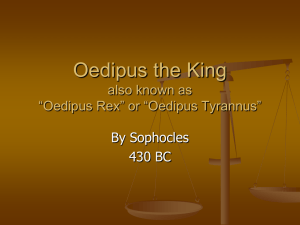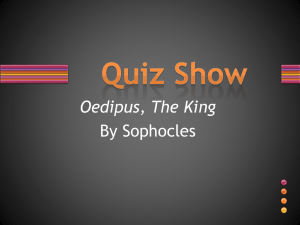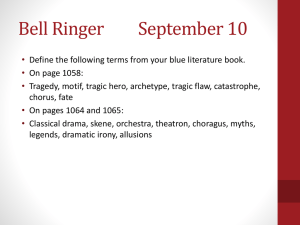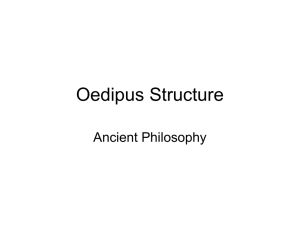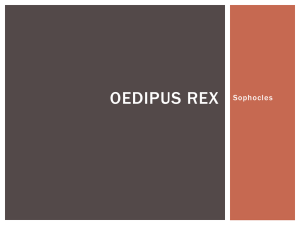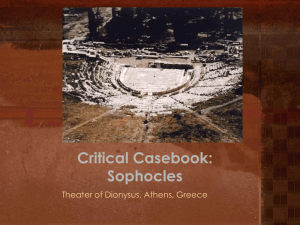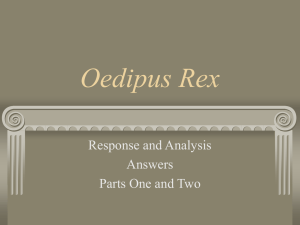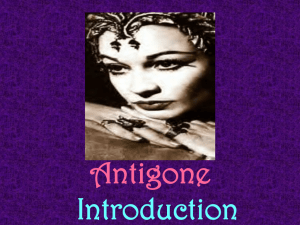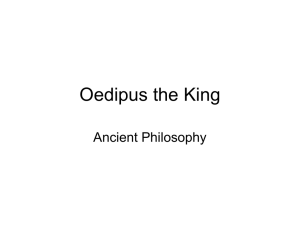PPT
advertisement
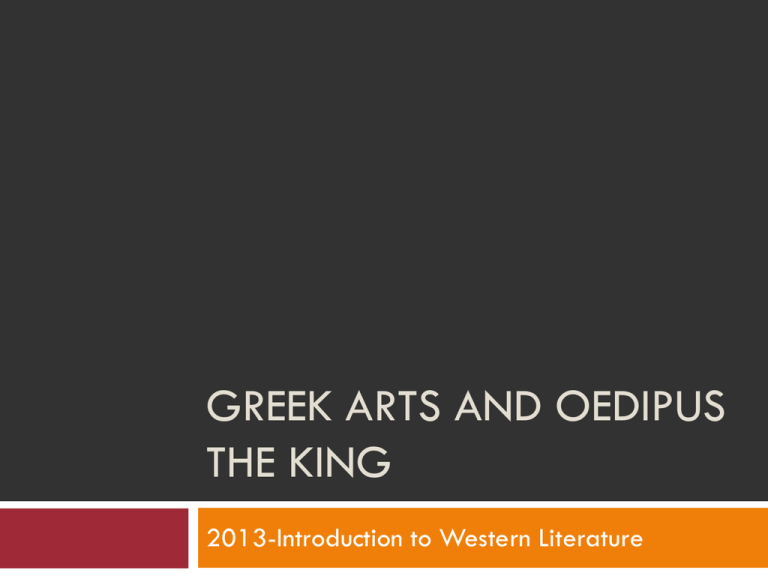
GREEK ARTS AND OEDIPUS
THE KING
2013-Introduction to Western Literature
今天上課內容
Oedipus the King
故事接龍
Greek Theatre
Greek Arts
小組討論
pedPediatrics(小兒科)、pedicure(腳病治療)、
orthopedics(整形手術,特別指嬰孩的整
形手術) 、pedometer(計步器)、
pedestrian(徒步的)、pedagogy(教學法)、
encyclopedia(百科全書),這些字有一個共同
的希臘文字根ped-;由此可見,在希臘文中小孩、
腳、教育與知識等多層意涵,巧妙地糾結在一個
字根ped-。
有趣的是,著名的伊底帕斯、他的名字、他的故
事、他所代表的典型正是以上諸多概念的縮影。
Oedipus: a pun
先看Oedipus一字的字源, oedi- 即
oidos變形的,加上 pus 即pous
腳,Oedipus的字面意思就是畸型的
腳(clubbed feet)或是腫脹的腳
(swollen feet)。此外,oidos當作動
詞的意思是「我知道」,所以
Oedipus的另一層意義是我知道關於
腳的事—伊底帕斯知道Sphinx謎語的
答案。
Group Discussion (1): Oedipus the King
Link the plot of the play!
Oral report: retell the story.
OEDIPUS
Story background
Sophocles’ Oedipus Rex
probably the most famous tragedy ever
written.
It is known by a variety of titles (the most
common being Oedipus Rex), including Oedipus
the King and Oedipus Tyrannus.
Sophocles first produced the play in Athens
around 430 B.C. at the Great Dionysia, a
religious and cultural festival held in honor of
the god Dionysus, where it won second prize.
In the play Oedipus, King of Thebes, upon
Ancient Greek Theatre
Three Theban plays: Not a trilogy
Oedipus the King Oedipus at Colonus Antigone.
Antigone was first performed in 442 BCE.
Oedipus the King was first performed c. 429 BCE.
Oedipus at Colonus was written shortly before
Sophocles' death in 406 BC and produced by his
grandson (also called Sophocles) at the Festival of
Dionysus in 401 BCE.
People and places to know:
Oedipus
Jocasta
Laius
Polybus
Merope
Sphinx
Teiresias (Tiresias )
Apollo
Delphi
Cithaeron
Thebes (the House of
Cadamus)
a winged female
monster in Greek
mythology having
a woman's head
and a lion's body
and noted for
killing anyone
unable to answer
its riddle
an ancient Egyptian image in the
form of a recumbent lion having a
man's head, a ram's head, or a
hawk's head
1
• Prologue and Parodos
2
• First Episode and First Stasimon
3
• Second Episode and Second Stasimon
4
• Third Episode and Third Stasimon
5
• Fourth Episode and fourth Stasimon
6
• Fifth Episode and Exodos
Introduction
•
The setting of the Oedipus
the King as in the case of
most Greek tragedies, does
not require a change of
scene. Throughout the play,
the skene with at least one
door represents the facade of
the royal palace of Thebes.
http://able
media.com/
ctcweb/nets
hots/oedipu
s.htm
PROLOGUE (1-150) OEDIPUS, PRIEST AND
CREON
Read (1)
Prologue (Priest, Oedipus, Creon)
The priests of Thebes appear before
Oedipus as suppliants, entreating him to
find some end to the plague.
Oedipus has already sent Creon to
Delphi, who arrives to report that the
killer of Laius must be sought out and
banished.
Oedipus vows to find the killer and
summons the people of the city.
Prologue: Oedipus, Priest and Creon
What is the dramatic purpose of
the prologue?
How does Oedipus characterize
himself (8)?
What is his attitude toward the
suppliants (13-14)?
Pollution/ miasma
blood pollution that
infects the family, and
for a royal family the
city itself
The Plague of Thebes, oil on
canvas,
Charles François Jalabeat
(French, 1819-1901)
Oedipus
"Oidi-pous“ in Greek means "swollen footed”
But we can also analyze Oedipus in at least two
other ways:
oidi-
to a Greek sounds like oida, oide = "I know, he
knows" (a central theme in the play)
-dipous to a Greek means the "two-footed one," with
obvious associations to the riddle of the Sphinx (another
central theme)
Oedipus
Man of action, caring but
haughty: 7ff, 71ff etc.
Revealer of the truth: 150
Solver of riddles: 443ff
(e.g.)
Parodos
The Chorus of Theban citizens
offer prayers to Zeus, Apollo,
Athena for release from the
plague.
Parados (151-215)
What is the reaction of the Chorus to the
advice of Apollo ('the Delian Healer') to
Thebes (154-157)?
What conditions in Thebes does the Chorus
describe)?
Delphi
The Pythia was
the priestess at
the Temple of
Apollo at Delphi,
located on the
slopes of Mount
Parnassus.
Priestess of Delphi
(1891) by John
Collier
chorus is an "act-dividing song":
– allows
for entrances and exits
– allows for the scene to change
– marks the passage of time
– chorus comments directly or
indirectly on what is going on
FIRST EPISODE
Part two
First Episode
Oedipus appeals for information and pronounces
his curse on the murderer.
Teiresias is summoned: at first he refuses to tell what
he knows, but aroused by Oedipus' taunts he
declares Oedipus the murderer.
Oedipus declares a conspiracy by Creon.
Teiresias declares that the murderer is
present, and will be found son and
husband to his mother.
First Episode (216-462) - Oedipus,
Chorus and Teiresias
Irony
Why does Oedipus summon Teiresias
(278-287)? What is Teiresias's reaction to
Oedipus's request for help (316-344)?
I must know. Know thyself!
But knowing is itself problematized in the
Oedipus the King: central to the text is
not only what is known and by whom, but
what it means to "know"-- what is "true"
knowing.
Insight and blindness
Apollo versus Oedipus:
•
•
divine versus human knowledge
Apollo
sun, day, clear, blazing, burning
– fever, blazing, burning: sender of plague and the
Healer
– intelligence, clear, seeing
– brilliance, poetry
– truth (knowledge), clear, seeing
– divine prophecy, clear, seeing
–
Prophet/ Tiresias
Teiresias, the seer of
Oedipus the King:
Sophocles’ and Seneca’s
versions
http://www.leeds.ac.uk/classics/lics/
2003/200305.pdf
South Italian Red-figure
bowl. Detail: Tiresias
seated holding sacrificial
knife as Odysseus (left)
stands by him
First Stasimon
What is the Chorus’s view of Teiresias's
accusations against Oedipus?
Suffering= pathos
What has Oedipus done to deserve such
awful suffering? Why must he suffer?
Tragedy=an aesthetic question mark
The dramatic expression of an enquiry into
suffering, an aesthetic question mark performed in
enacted pain.
While representing an instance of suffering in
dramatic form, always asks why it has occurred.
Pathology= the study of diseases
Etiology= the causes of diseases or a study of
causes
hubris
"ungodly pride" (hubris) or "tragic
flaw" (hamartia)
p. 9
Know thyself, Oedipus.
You denounce me, but you
do not yet know yourself.
SECOND EPISODE (CREON,
OEDIPUS, CHORUS; JOCASTA)
Part three
Second Episode , 513-862. (Creon,
Oedipus, Chorus; Jocasta)
Creon is indignant at Oedipus' accusations.
They argue over the charge. Jocasta tries to intervene.
Kommos.
The Chorus advise restraint and Oedipus lets Creon
go, though he declares him an enemy. Oedipus tells
Jocasta the source of the dispute.
Jocasta tells the story of Laius' death, and Oedipus
recognizes many details: but he was a lone killer,
whereas a band of killers was reported.
Oedipus worries about the oracle; Jocasta denounces
its veracity, adducing the prophesy about her son.
Second Stasimon (Chorus)
Ode to the sanctity of divine law.
The tyrant who ignores justice and reverence for the
gods will fall.
The oracles must be true.
Third Episode , 911-1085. (Jocasta,
Messenger, Chorus; Oedipus)
A messenger arrives from Corinth announcing the
death of Polybus and Oedipus' ascension.
He allays Oedipus' fear of the oracle (that he will
marry his mother) by telling him of his true birth.
Over Jocasta's objections Oedipus vows to continue
his search for the truth. Jocasta runs into the palace.
THIRD EPISODE AND
THIRD STASIMON
Part four
Third Stasimon , 1086-1109. (Chorus)
Ode to Mt. Cithaeron: we will soon
know the parentage of Oedipus.
Part Fifth: Fourth Episode (Oedipus,
Shepherd, Chorus)
The shepherd arrives who exposed the
infant of Laius and escaped when Laius
was killed. Oedipus' parentage becomes
clear. Oedipus rushes into the palace.
Fourth Stasimon (p.27) (Chorus)
No man is blest: happiness is but an illusion, for
even the great power and blessings of Oedipus
have come to a fall.
Your example, Oedipus,
Your example, your fate, your disaster,
Show that none of us mortals
Ever knew, ever felt what happiness truly is.
FIFTH EPISODE AND
EXODOS
The sixth part: p.28-32
Exodos , 1223-1530. (Messenger, Chorus;
Oedipus, Creon)
A messenger announces the suicide of Jocasta and
the self-inflicted blinding of Oedipus. Oedipus
appears to lament his fate. Creon appears.
Oedipus begs him to take care of his children;
Antigone and Ismene (mute) arrive to comfort their
father. Creon persuades Oedipus to return to the
palace, and assumes the kingship.
Chorus p.33
There goes Oedipus—
He was the man who was able
To answer the riddle proposed by the Sphinx.
Mighty Oedipus—
He was an object of envy
To all for his fortune and fame.
There gores Oedipus—
Now he is drowning in waves of dread and despair.
conclusion
Look at Oedipus—
Proof that none of us mortals
Can truly be though of as happy
Until he is granted deliverance from life,
Until he is dead
And must suffer no more.
GREEK TRAGEDY AND
THEATRE
An Overview
由演員為觀眾表演故事。說得更簡
單的話:戲劇是由甲扮演乙﹐有丙
觀看。這定義與另一本戲劇史中寫
的一樣:凡能滿足以下條件的就是
劇場(theatre): A represents X
while S looks on.(FischerLichte 257). 甲(A)是演員﹐乙
(X)是故事裡的人物﹐丙(S)
是觀眾。
希臘戲劇是這個主流的源頭。希臘的城邦
之一,雅典﹐從西元前534年起就奠立了
悲劇節,綿延長達三個世紀以上,其間傑
作至今仍為人類瑰寶。戲劇也是表演藝
術,希臘劇場的演出形式及安排,為後世
樹立了一個長青的典型。要了解這份寶貴
的遺產,最好從雅典著手,因為它既是希
臘戲劇的搖籃,也是它的中心。
就人類戲劇史而言,皮氏最大的貢獻,
是他在西元前534年創立了悲劇競賽。
希臘悲劇與宗教儀式有密切的關係。
真正起源已經不可考。現在一般認為起源於酒神
在祭祀中,合唱隊(Chorus)會表演歌舞祭祀酒神
戴奧尼索斯(Dionysus),這種歌舞被稱為「酒神
頌」 。
「酒神頌」發展到後來,逐漸擴大到神話和英雄
傳說的範圍——悲劇的形式逐步發展和完善,成
為一種固定的敘事體。
他是天神宙斯 (Zeus) 與凡女西蜜莉
(Semele) 生下的兒子,宇斯的妻子希拉
(Hera) 出於嫉妒將他擲入火中,幸被仙女
救出而得重生。
戴奧尼索斯的經歷因此象徵著生命循環
(出生、成長、衰敗、死亡、重生)與四
季交迭(春、夏、秋、冬),希臘人祭祀
他祈求香火傳續,四季豐饒,而身為酒
神,他也常讓人聯想到一些不理性的力
量。
古希臘悲劇的表現主題不在於悲劇性的故事本身,
而是在於表現崇高壯烈(sublime and magnificent)的英
雄主義思想。
根據亞裡斯多德Poetics中的定義,古希臘悲劇「描
寫的是嚴肅的事件,是對有一定長度的動
作的摹仿;目的在於引起憐憫和恐懼,並
導致這些情感的淨化;主人公往往出乎意
料的遭到不幸,從而成悲劇,因而悲劇的
衝突成了人和命運的衝突」。
Tragedy= Goat song
The word tragedy literally means
"goat song," probably referring to
the practice of giving a goat as a
sacrifice or a prize at the religious
festivals in honor of the god
Dionysus.
70
Alice Y. Chang
Thespians
希臘戲劇的第一個確切紀錄見之於西元五
三四年,這一年「城市的戴神節」組織改
變,在各項活動中加入了悲劇演出競賽。
戲劇在此以前勢必早已存在,否則不會又
有此競賽。這時其中唯一可考的戲劇家就
是賽士比斯(Thespis),也就是第一次悲劇
競賽的冠軍得主,並且,由於他也是第一
個?是人所知的演員,以後演員們就常被叫
做賽士比斯之徒(Thespians)
和諧: 理性與非理性
在宗教的領域中,竟然包括了非理念力
量,這顯示希臘人相信對自然的每一部分
都應適當崇敬,否則災厄就會隨之而產
生。
希臘人始終努力,要在所有相衝突的力量
之間無論是內心的還是外在的,達成和
諧。
Sophocles生平
496B.C~406B.C
生於雅典北邊名叫Colonus的村落
受良好教育,擅音樂、體育、舞蹈…
等
因為貌美與音樂天賦被推選為慶祝戰
爭勝利祭儀中少年合唱團領導
索福克里斯
生於一個富裕家庭,當時正適逢雅典
城邦的黃金時期,雅典人活於滿懷自
信的年代,他們的哲學家相信「人是
衡量一切的標準」。
但過分的自信令他們傲慢而又熱忱於
爭名逐利。當時詭辯學應運而生,處
士橫議,傳統的信仰受到挑戰。索福
克里斯對這種風尚深感憂慮,在劇本
中,他反複出了他的勸導與警告。
Sophocles生平
曾任以雅典為盟主的「德利亞聯盟」
的財政總管
兩度被選為將軍(政府的最高官位)
祭師
「生前完滿,身後無憾。」
Sophocles創作
生涯劇作有110部左右(130、125、123)
現存七部戲劇及少數殘本
ㄧ:阿傑克斯(Ajax c.450B.C)
二:安蒂岡尼(Antigone c.442B.C)
三:屈欽妮亞(Trachiniae c.413B.C)
四:伊底帕斯王(Oedipus Rex c.425B.C)
五:伊蕾特拉(Electra c.410B.C)
六:菲洛特提斯(Philoctetes c.409B.C)
七:伊底帕斯在柯隆納斯(Oedipus at Colonus
c.401B.C)
悲劇
角色:多半是身分地位高於一般民眾的
英雄、國王、貴族或神祈
劇情:際遇由盛而衰
使用語言較高雅
蘊含積極意義
強烈道德意涵
喜劇
角色:多半是地位低於一般大眾的人物
劇情:自逆境漸入佳境
使用語言多為一般生活用語
發展晚於悲劇
撒特劇(薩提洛斯劇)
輕鬆詼諧、滑稽戲謔
語言粗鄙、動作放縱
嘲諷
作為嚴肅悲劇演出後的餘興
希臘藝術的特質
希臘人富於民主思想和創造精神的天性,個性
活潑開放情,崇尚運動,追求自由自在的樂
趣。因此藝術表現上呈現出充滿健康、自然、
樂觀、優雅等的特質,而有別於近東藝術那種
超自然的、宗教的神祕感。在同一個時代,近
東藝術中,作者只是奉命行事去完成,作品中
沒有個人的創意也不留名,可是到了希臘時
代,個人地位提昇,藝術品的製作者才逐漸受
重視並留有名字。
希臘藝術的特質
希臘人因其唯美、唯善觀及優美之地埋、氣候
環境,故追求完美,此種完美之要求亦及於人
體及生活;再因其有優美之氣候與環境,對於
戶外活動亦極為熱衷,於是有各種競賽、體能
活動及奧林匹克運動會。
Ex. 雕刻
早期希臘雕刻受到埃及和近東各國的影響
直到「黑暗時代」過後,希臘人的雕刻開始建
立自己的風貌,展開蓬勃的發展,並對往後歐
洲藝術產生極大的影響。
希臘雕刻的風貌,主要靠文獻上的記載和羅馬
時代的仿製品而得知;由於年代久遠、歷經戰
亂和人為破壞,大部份原作己所剩無幾。
雕刻
希臘的雕刻和 建築,是互為一體的,例如神廟
建築上的破風雕刻﹝山形牆雕刻﹞或浮雕飾
帶、墓碑上的浮雕……等。
除了和建築相結合之外,獨立性的雕像也很可
觀, 其創作泉源來自「人體美」,是歷史上
「裸體雕刻」的創始。
http://vr.theatre.ntu.edu.tw/hlee/course
/th9_1000/open-08-broadcast.htm
米隆﹝Myron﹞之擲鐵餅
者﹝Discus-Thrower﹞
年代:450 B.C.
希臘之繪畫四個時期
由器皿上的彩繪來看
﹝一﹞幾何形風格(約 11OO ─ 7OO
B.C.)
﹝二﹞東方風格(約 75O ─ 6OO
B.C.)
﹝三﹞黑體人像繪畫(約 7OO ─ 5OO
B.C.)
﹝四﹞紅體人像繪畫(約5OO B.C.)
http://vr.theatre.ntu.edu.tw/hlee/course/th9_1000/open-08
broadcast.htm
﹝一﹞幾何形風格(約 11OO ─ 7OO B.C.)
這是希臘本土構成性
裝飾的表現,在陶甕
上畫滿告種簡單而有
規則的幾何圖飾,這
類型的作品起初都沒
有人物的裝飾圖案,
直到西元前第八世紀
才有明確的人物形象
出現。
﹝二﹞東方風格(約 75O ─ 6OO B.C.)
早期的陶甕仍採用幾何圖案,由於當時希
臘和近東地區商務接觸而產生的風格,以
故事作為描繪的內容,人物、動物成為裝
飾的主題,輪廓明確,筆觸肯定,造型生
動,作品尺寸隨之增大。
﹝三﹞黑體人像繪畫(約 7OO ─ 5OO B.C.)
此種畫風存在於古樸時期至公元前六世紀末葉。以雕刻家
埃司克埃斯﹝Exekias﹞之作品,題為「埃加士與艾契列
士下棋」﹝Ajax & Achilles Playing Draughts﹞之陶罐
為例,其特色為表面光滑、人體皆為黑色、尖鼻大眼、布
局均衡、人物之腳部均在同一半畫面上、無景深,並有幾
何形圖案。在公元前六世紀末葉左右,希臘陶工與畫工在
社會中已漸有相當地位、故多在其作品上署名。
埃加士與艾契列士下棋
年代:540 B.C.
說明:黑體人像繪畫
﹝四﹞紅體人像繪畫(約5OO B.C.)
公元前五世紀左右,紅體人像繪畫逐漸取代黑
體人像繪畫。人物皆為紅色,所有人物之立足
點已非同在一水平線上,而係分布在並不規則
之層次,與重疊之人物共同產生遠近距離之感
覺,同時各人物皆有不同之動作,頗具動感。
對人體之處理方面,與黑人物畫風相較,較為
活潑、寫實,而非生硬、規律化。
91
Alice Y. Chang
Earliest coinage: Electrum
Electrum is a naturally occurring alloy of
gold and silver, with trace amounts of
copper and other metals. It has also been
produced artificially.
The ancient Greeks called it 'gold' or
'white gold', as opposed to 'refined gold'.
Its color ranges from pale to bright
yellow, depending on the proportions of
gold and silver.
Oldest Lydian Lion electrum
http://rg.ancients.info/lion/
Sophocles’ Antigone
“Make
your profits, import
electrum from Sardis if you
wish, and gold from India” (Anti
1037-1039).
An Athenian Owl
Silver Tetradrachm, with the Owl
standing on a olive twig, a crescent on the
upper left and "ΑΘΕ" in front and Athena
wearing an ornamented helmet, 454 - 449
BC.
c. 430 BC - 23 X 27 mm diameter, 16.5g
Group discussion (2)
Is Oedipus a true hero? Why or
why not?
